Views: 49
In case you didn’t know, jam sessions are where a group of musicians get together and let it fly.
Musicians tend to show off, but if professionals, who cares?
![]()
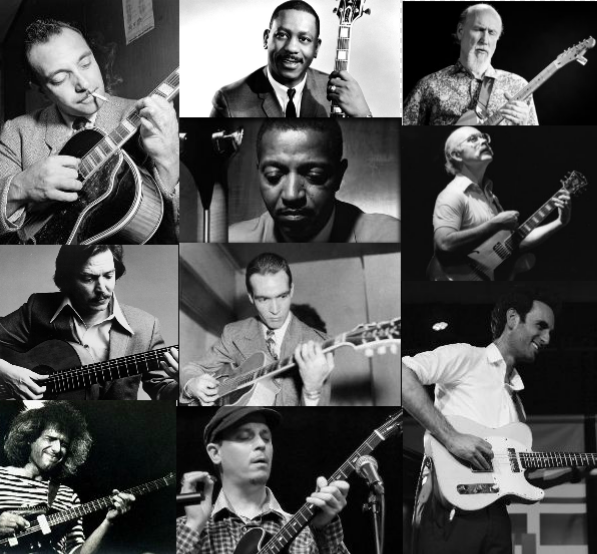
Views: 49
In case you didn’t know, jam sessions are where a group of musicians get together and let it fly.
Musicians tend to show off, but if professionals, who cares?
![]()
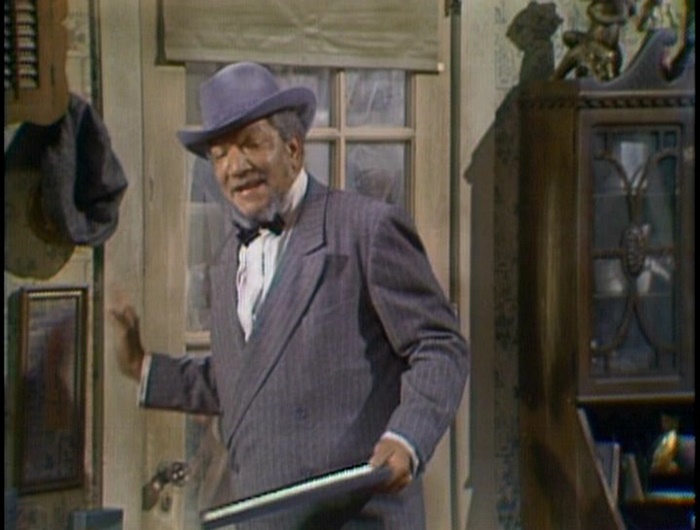
Views: 64
Getting the Gardens ready for winter. Well planting time’s over and this was a so so year. Sure had a ton of Tomatoes and green bell peppers. But the Cantaloupe and Watermelon not so good. Cucumbers were also so so. Garlic and onions were awesome. But now it’s time to get the gardens ready for next year.
I’m going with only two gardens plus sharing another. My first garden will be something new for me. It’s my tree, garlic, onion, and berry garden. I’m going with a Lemon, Orange, Peach, Plum, and Nectarine trees.

This garden will be the shared garden. Tomatoes, Watermelon, and Cantaloupe.

And finally my world famous ghetto garden. This year I’m changing the name to the Fred Sanford Garden. This will be strictly a vegetable garden. Last year I went with heirloom seeds. Next year we do the plants.
Wish me luck.
![]()

Views: 81
The Greatest Female Singers of All Time.
Who is the greatest female singer of all time?
There have been so many incredibly talented singers over the years, all with different types of voices, ranges and styles.
![]()

Views: 53
We love our black accent pieces. We tend to use black chairs and tables in our decorations. Some of the pieces are seasonal and some are year round. I can’t take credit. My wife usually picks out the items and we will then either restore them or change them all together.
Some of the pieces are Antiques, some Vintage, and some are just cheap pieces of furniture that add that special touch.

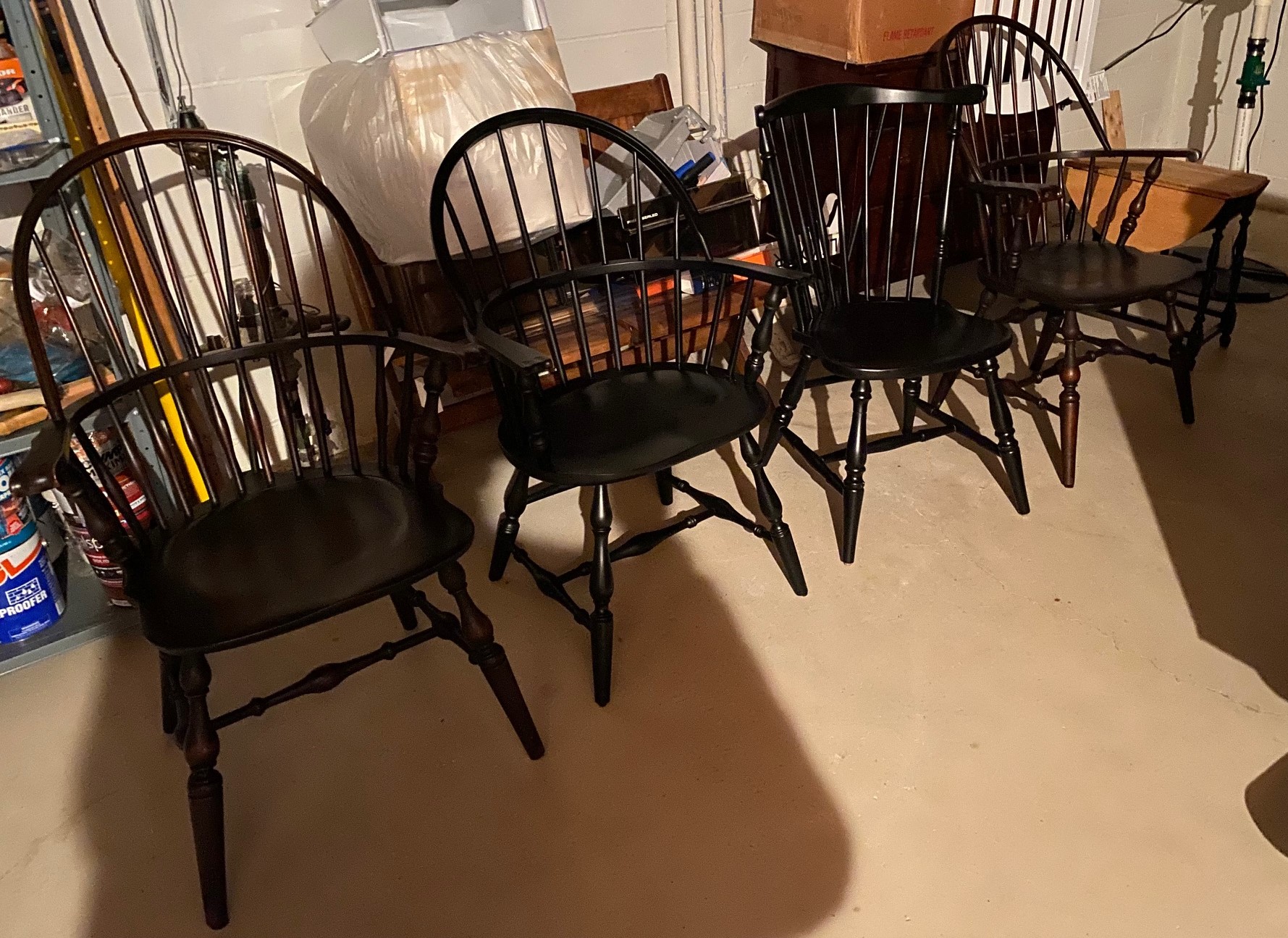

The ugliest piece we ever bought. Paid $3.00. I couldn’t do anything with it.

![]()

Views: 28
Hot Pizza Appetizer |Pepperoni Pizza Dip Recipe.
When you add the ingredients of a delicious pizza with the heavenly cream cheese, you get this amazing hot pizza dip! Caution: don’t serve this unless you want friends and family to ask you to make it over and over!
Ingredients you will need:

Chop 2 tablespoons green peppers. Thinly slice 2 tablespoons onions.

In a bowl, mix 1 8 oz. package cream cheese, softened, and 1 teaspoon Italian seasoning.

Spread mixed cream cheese across bottom of 9″ pie pan.

Combine 1 cup mozzarella cheese and 3/4 cup Parmesan cheese in bowl.

Sprinkle half of the cheese across the top of the cream cheese in the pan.

Pour 1 8 oz. can pizza sauce over the top of cheese mixture.

Spread the sauce evenly.

Put remaining cheese on top of pizza sauce.

Spread chopped green peppers and onions across cheese.

Place 1/4 cup mini-pepperoni across the top. Place in microwave and heat on high for 3 or 4 minutes, or until cheese is melted.

Remove from microwave. Let sit for 2 minutes before serving. Enjoy!

![]()

Views: 29
Apple Streusel Cheesecake Bars | Cinnamon Apple Cheesecake Treat. Brace yourself; this Apple Streusel Cheesecake Bar is so delicious it will knock you out of this world! Just make sure to grab yourself a piece early, because once your friends and family taste them, they’ll be gone in a flash! Pick up some apples and get out the baking pans! It’s time to make dessert!
Ingredients you will need:
Preheat oven to 350 degrees. In a large bowl, pour 1 package oatmeal cookie mix. Add 1/2 cup butter.

Combine butter with cookie mix. Try using the Rada Food Chopper, a useful tool that makes this an easy task.

Set aside half of the crumb and butter mixture for later.

Place the other half in a 9 x 13″ pan. With most pans you should line with foil and grease lightly. With the Rada Rectangular Baker, no foil or grease is necessary. Bake at 350 for 10 minutes.

While the mixture is baking, combine 2 packages cream cheese, 1/2 cup sugar, 2 eggs and 1 teaspoon vanilla extract.

Beat until smooth.

Core and slice 3 apples. Try using the Rada Vegetable Peeler to peel and the Heavy Duty Paring Knife to slice.

With a large knife, finely chop the apples. The Rada French Chef Knife is ideal for this. In a bowl, combine apples, 1/2 teaspoon ground cinnamon, 2 tablespoons sugar, and 1/4 teaspoon ground nutmeg. Mix well.

When cookie mixture is done baking, remove from oven and spread cream cheese mixture evenly across the top.

Sprinkle cream cheese mixture with apple mixture.

Chop 1/4 cup pecans or walnuts.

Add remaining cookie mixture to top. Sprinkle with 1/4 cup chopped pecans or walnuts. Drizzle with caramel ice cream topping. Bake at 350 degrees for 30-40 minutes or until topping has set.

Serve and enjoy!

![]()

Views: 37
Banana Bread Recipe.
Banana bread from your kitchen is a snap when you use this easy recipe! Just combine the ingredients, mix, bake, and enjoy with your family.
Ingredients you will need:
Preheat oven to 350 degrees. Cream sugar, brown sugar, and margarine. Add milk, eggs, bananas, grated orange rind, baking powder, soda, salt, flour, vanilla, and chopped pecans. Beat for 3 minutes.
Add batter to two greased loaf pans. Bake for 1 hour or until toothpick inserted in center comes out clean.
Serve and enjoy!
![]()

Views: 26
Bite-Sized Pizza Snack | Pizza Puff Recipe.
Be the hit of the next party with these quick and easy pepperoni pizza puffs. These appetizers are great at any number of different events. They are easy to make and in no time at all you will have a great snack. Even better, kids love them!
Ingredients you will need:
Preheat oven to 375 degrees. Grab the pepperoni and chop it into smaller slices. Kristy used the Rada Cook’s Utility knife. Set aside.

Mix together flour, baking powder, and Italian seasoning. The Rada Non-Scratch Cook’s Spoon with holes is shown below.

Add milk and eggs. Whisk together. The Rada Handi-Stir is great for the job.

Add the chopped pepperoni and cheese mix. Mix together and then set aside for 15 minutes. Stir well one last time.

Spoon your mixture into a muffin pan. Then bake in the oven for 20-25 minutes or until golden.

When the pizza puffs are done, place them on a plate with pizza sauce and they are ready to be served!

![]()

Views: 35
Drumstick Bars Recipe.
A great treat for both Adults and Kids.
Ingredients you will need:

FIRST LAYER: Crush your peanuts. The Rada Food Chopper is your best bet for this task.

Mix crushed vanilla wafers, melted butter and 2/3 cup of the crushed peanuts. Put in a 9×13” pan. Bake at 350 degrees for 10 minutes.

SECOND LAYER: Mix cream cheese, peanut butter and powdered sugar until smooth. Fold in 2 cups whipped topping.

Spread over first layer.

THIRD LAYER: Mix chocolate pudding and milk. Chill to set. Spread over second layer.

FOURTH LAYER: Spread 2 cups whipped topping over third layer.

Sprinkle 1/3 cup of the chopped peanuts over top. Grate chocolate bar (Rada Cutlery Vegetable Peeler shown above) and sprinkle over top. Chill overnight.

![]()

Views: 44
Music for the weekend.
Play any song that has something to do with the weekend. It can be about the weekend, have weekend in the song or the title. Also it can be about Friday, Saturday, or Sunday.
Since we have a holiday Monday, Mondays included. So, this should be an easy one.
![]()

Views: 27
Little League World Series: California’s El Segundo wins title with walk-off home run vs Curaçao.
California’s El Segundo is bringing home the Little League World Series championship title after a 6-5 victory over the team from Willemstad, Curaçao, on Sunday.
The thrilling game ended with a walk-off home run from Louis Lappe, who was given a perfect setup from the booth by ESPN broadcaster Karl Ravech.
With the score tied in the sixth inning, Lappe stepped to the plate.
“Curaçao has not allowed a home run at the World Series,” Ravech said in an announcer jinx for the ages. Almost instantly, Lappe, the series’ home run leader, sent one flying for the win.
California has been in the championship game 24 times and now has its eighth title. The region has the most victories by any U.S. team but hadn’t won since 2011.
The team had some of the best bats in the tournament, including Lappe and Brody Brooks. En route to the U.S. title on Saturday, Lappe had five RBIs, including a three-run homer as California beat Texas 6-1.
But Curaçao didn’t go down without a fight. Having appeared in the LLWS championship four times, the team was hoping for its first win since 2004 — its only title. Last year, the team made it to the championship game and lost to Hawaii 13-3. Five of its players returned from last year’s disappointment, the most in the tournament.
Down 5-1 in the top of the fifth, Nasir El-Ossais showed the grit of a seasoned veteran. With two outs, he tied the game 5-5 on a dramatic grand slam to right field off Max Baker.
“I am sweating right now, and not from the heat,” El-Ossais’ dad said after the play, adding that emotions were at an all-time high.
Curaçao overcame a big deficit thanks to El-Ossais, but California’s pitching strength and defense won it. Brooks, a shortstop and strong pitcher, tied the World Series record by scoring 13 runs. On Sunday, he had a single and finished the tournament with 12 hits and three home runs.
In a tear-filled postgame interview, El Segundo manager Danny Boehle said he told his team “the game’s not over.” He was surprised Curaçao pitched to Lappe, who said he was close with the Curaçao players and offered kind words after hitting the winning home run.
There was plenty of sportsmanship all over the stadium in South Williamsport, Pennsylvania. “Great job, keep your head up,” Lappe recalled telling the opposing team.
California also posed for photos with Japan after the victory:
El Segundo’s players will go back to school soon, and they’ll have plenty to share with their classmates. Throughout the tournament, they were sent positive messages from the likes of Los Angeles Lakers’ and multiple Los Angeles Dodgers stars.
On Sept. 10, they will be celebrated in their hometown with a parade.
![]()

Views: 47
BIG MAC SALAD (CHEESEBURGER SALAD).
This Big Mac salad recipe (cheeseburger salad) makes an easy, healthy, low carb lunch or dinner in just 20 minutes, with simple ingredients.
The inspiration for a hamburger salad came from my childhood memories of rare stops at McDonald’s after gymnastics practice. We seldom ate out when I was growing up (my parents much preferring home cooked meals), so even though I loved my mom’s food, those unexpected stops for fast food were such a treat. Now I try to avoid all those processed ingredients myself, and with this keto Big Mac salad recipe, I can enjoy the same flavors at home, all the time — and so can you!
Let’s be real — the key to this cheeseburger salad is the Big Mac salad dressing! The sauce at the fast food joint is loaded with sugar, but I sweeten mine with Besti powdered instead. It’s just as sweet and has no aftertaste, but has 0 net carbs, 0 calories, and unlike most sweeteners, dissolves easily for a smooth texture. Try it out and see for yourself!
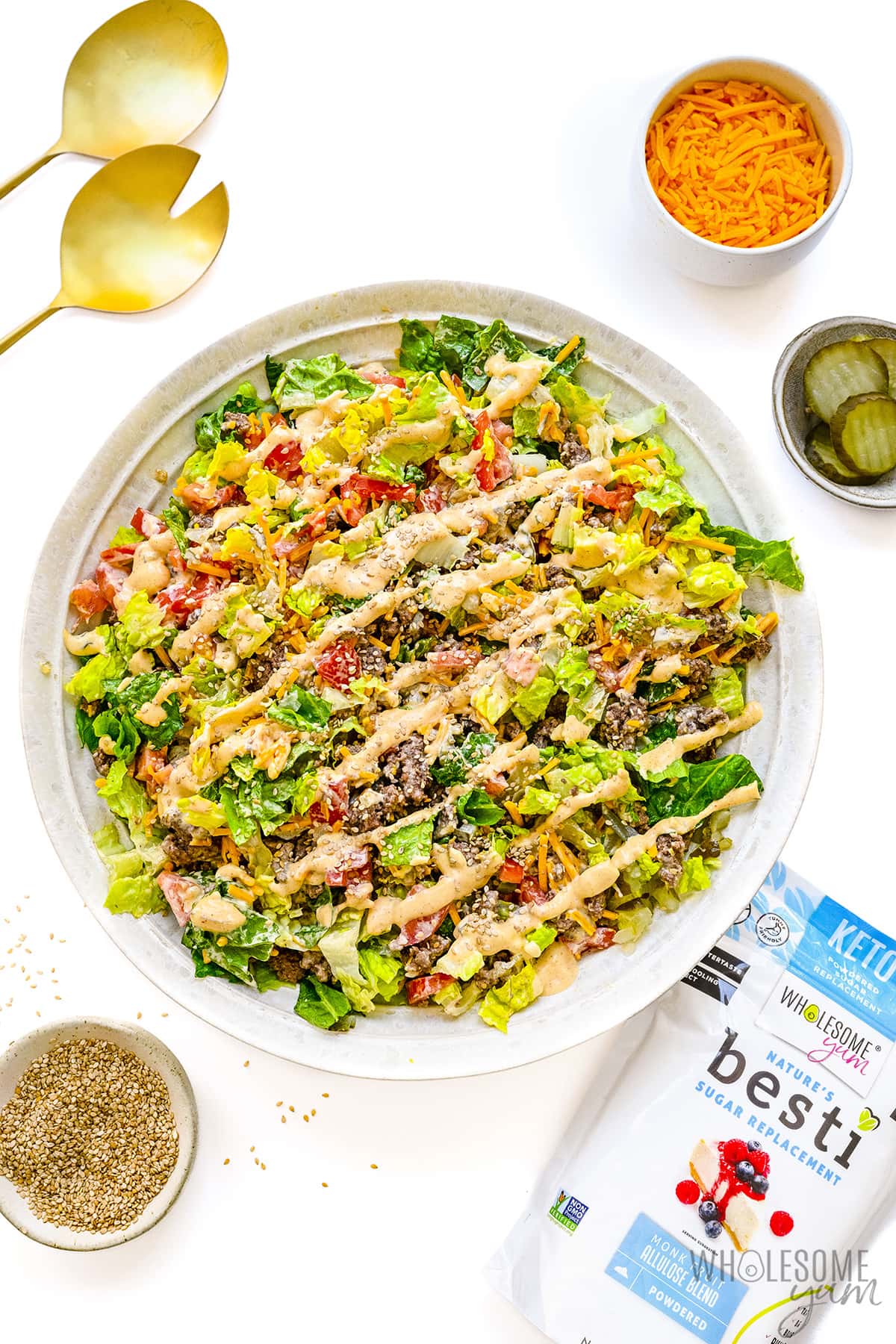
This section explains how to choose the best Big mac salad ingredients, what each one does in the recipe, and substitution options. For measurements, see the recipe card below.
The main ingredients for this salad are very similar to what you’d find in a Big Mac:
The dressing for this hamburger salad is very similar to my sugar-free Thousand Island dressing:
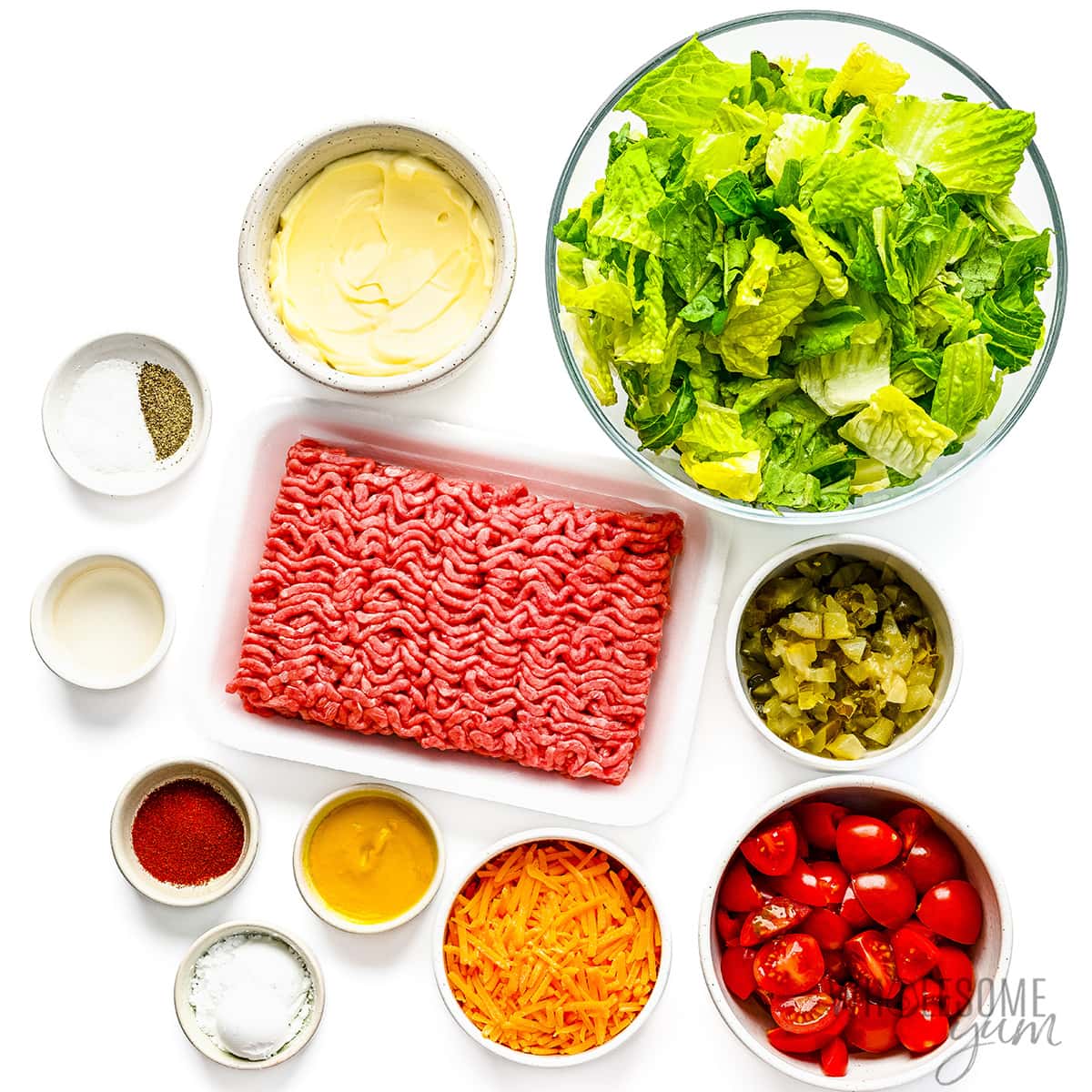
This section shows how to make cheeseburger salad, with step-by-step photos and details about the technique, to help you visualize it. For full instructions, including amounts and temperatures, see the recipe card below.
TIP: Need thinner sauce?
If the dressing is thicker than you like, you can thin it out with water or oil and puree again.


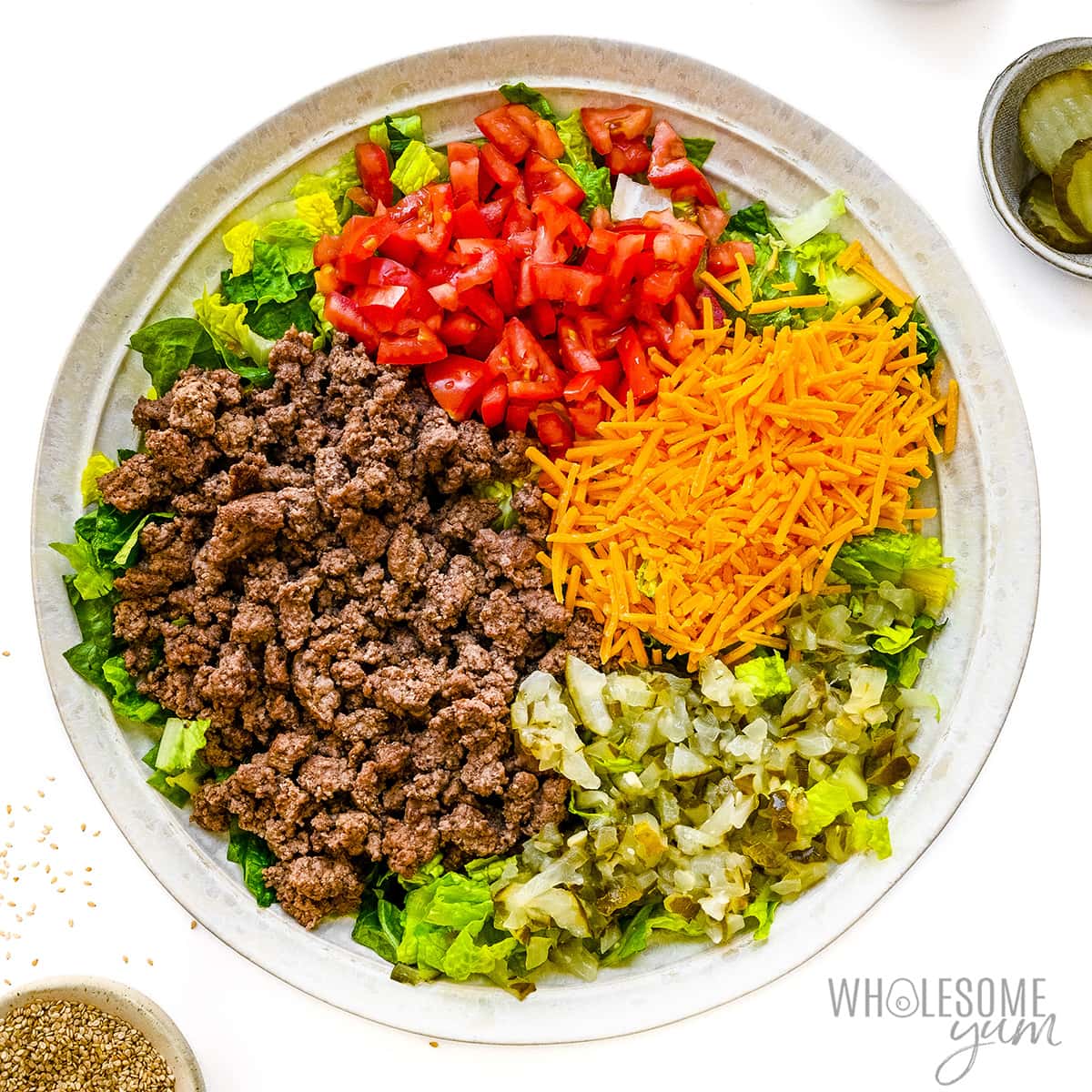
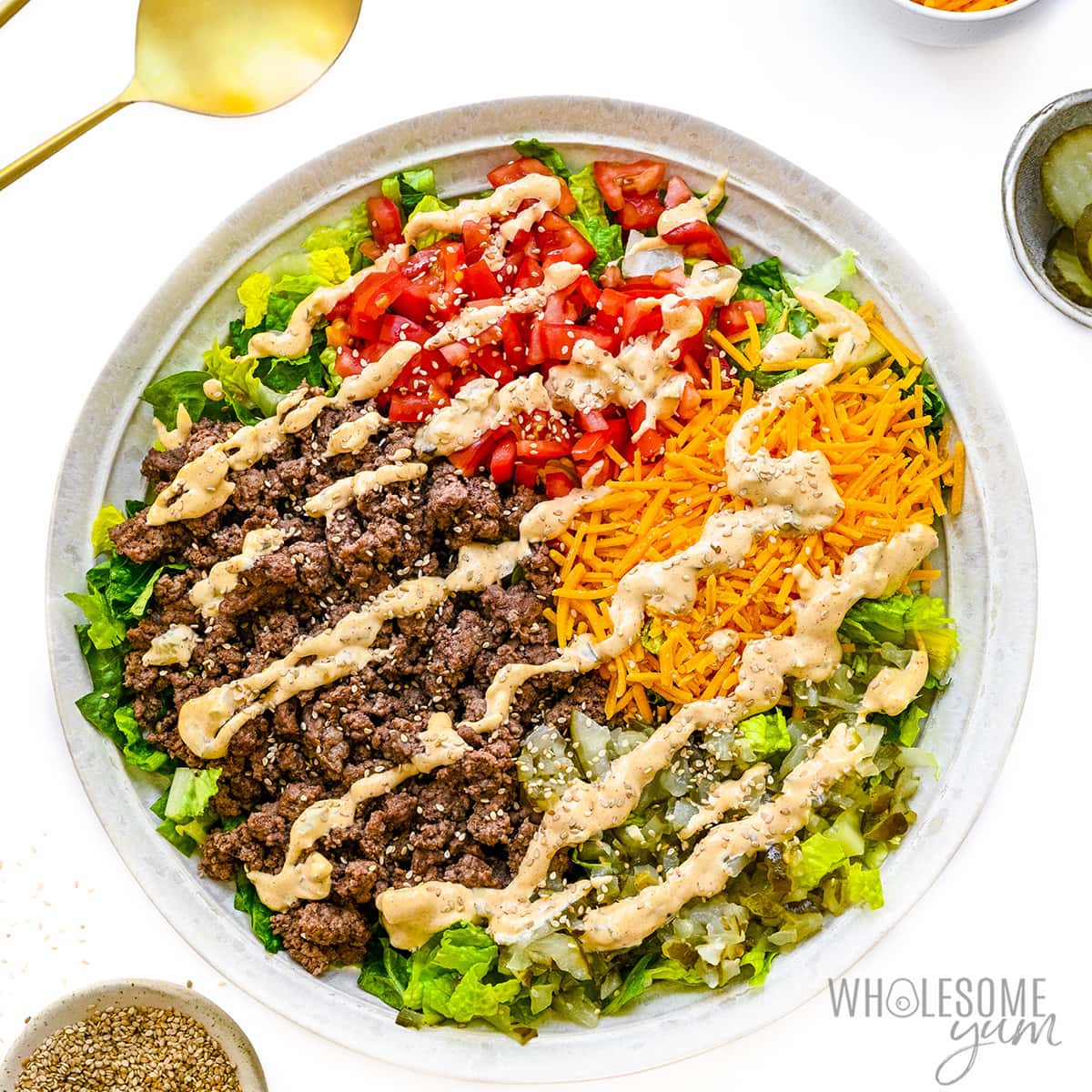
![]()
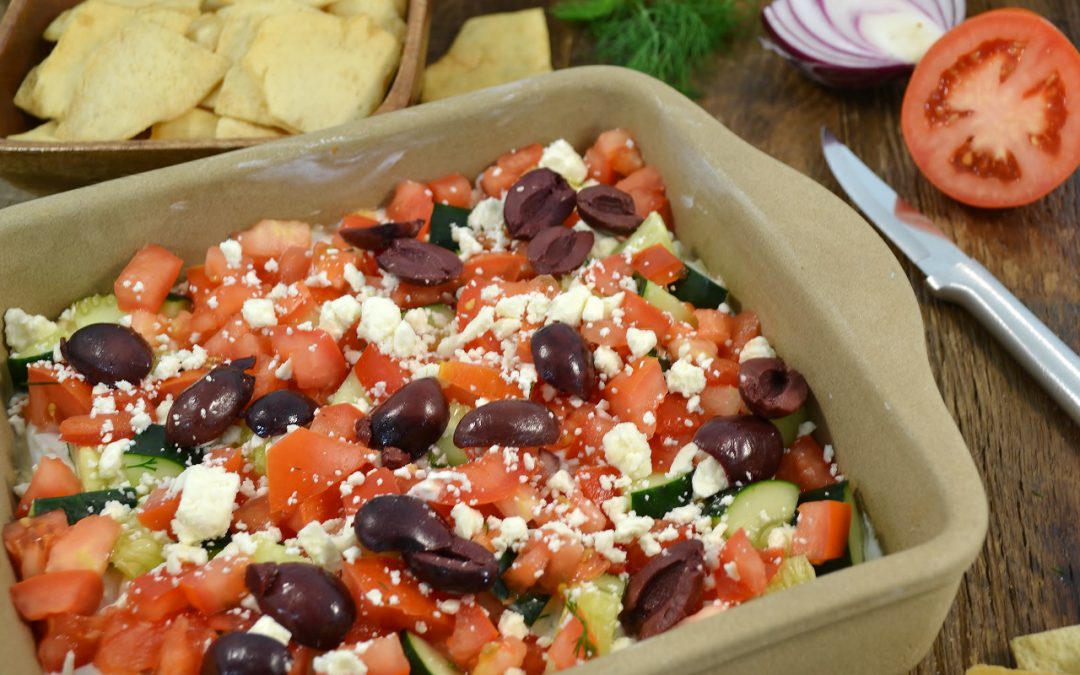
Views: 55
![]()
Views: 79
Let the good times roll. Free for all weekend music. We’re coming to the end of SUMMER SO LET’S GO OUT WITH A BANG.
Play whatever songs make you think about this great opportunity we have to enjoy the great songs that are out there.
So there are a few of my favorite’s. Of course I do have thousands.
![]()

Views: 44
Let’s catch up on the gardens. I should have done this back in June. But better late than never. This year we had 16 gardens. I started out with six, but ended up with my two what I call ghetto gardens.
We had a large variety of vegetables and this year I have some fruit trees. Peach, Orange, Cherry, Nectarine, Fig, Plum, and Lemon. My Cucumbers, Cantaloupes, Watermelons are not doing well. Garlic, Zucchini, Peppers, and Tomatoes are doing very well. I tried buying plants from the Amish this year. Next year all my plants will be from the Amish.
We had a gentleman who moved here from the South. Here’s a few plants he’s trying.


Did you guess Cotton? He’s actually growing a few cotton plants in Ohio. And below the one gardener planted four watermelon plants. This is back in June.

Here’s the four plants two days ago.

![]()

Views: 32
‘All the neighbors know who she is’: How one woman built a flower farm across eight yards.

Rachel Nafis, waist-deep in corncockles, cut the blush-colored flowers growing in her neighbor’s yard as her eyes wandered to the front door.
“I hope Tom comes outside to say hello,” she said as she placed the cut stems in a bucket of water.
Soon, a smile crept across her face as Tom Weaver opened the door and wheeled himself onto the porch.
“It’s so wonderful to see flowers growing outside my window,” he said from his wheelchair. “I love seeing them. They smell so good.”

For three years, Nafis, a one-woman florist, has grown sunflowers, dahlias and corncockles outside Weaver’s home, one of eight neighbors who have donated their yards to Psalter Farm Flowers, a loose collective of cutting gardens that is a draw with San Diego flower shops, event florists and bouquet lovers.
Not surprisingly, the flowers burst out of yards in various states of bloom due to the seasons. Around the corner from her home base, across the street from Webster Elementary School in City Heights, yellow and pink strawflowers and delicate blue scabiosa pincushions grow tall in raised beds.
A quarter mile in the other direction, pink bellflowers and the conclusion of fragrant sweet peas grow in neat rows behind the rental home of Sophie Thompson.
“All of my gardens are in places where people cannot care for their yards the way they would like,” said Nafis, 36. She also cultivated the alley behind her 800-square-foot home. “I feel I’m adding value to their homes and our neighborhood.”

Thompson agreed. “I don’t know much about farming itself, but I’m impressed how Rachel has increased the biodiversity,” she said of the neighborhood, which is among San Diego County’s poorest. “There is less infrastructure and greenery, fewer markets and more liquor stores here. But she’s taught us that all neighborhoods can be beautiful.”
Mindful of trends but not beholden to them, Nafis prefers growing seasonal flowers that speak to her. “I like fragrant flowers like roses, sweet peas and scented geraniums,” she said of the flowers blooming in her front yard and backyard. Right now, the cool season flowers — snapdragons, strawflowers, sweet peas and poppies — are transitioning to ranunculus and anemones and summer annuals like dahlias, zinnias and cosmos. “I try to grow things that don’t ship well,” she said. “Most florists are getting things imported from out of the country. I like to grow things that would get damaged in shipping or not last that long and florists would like to source locally.”
To passersby, the colorful cutting gardens stand out against the lawns, many of which have turned brown after California was asked to cut back on water during the drought.

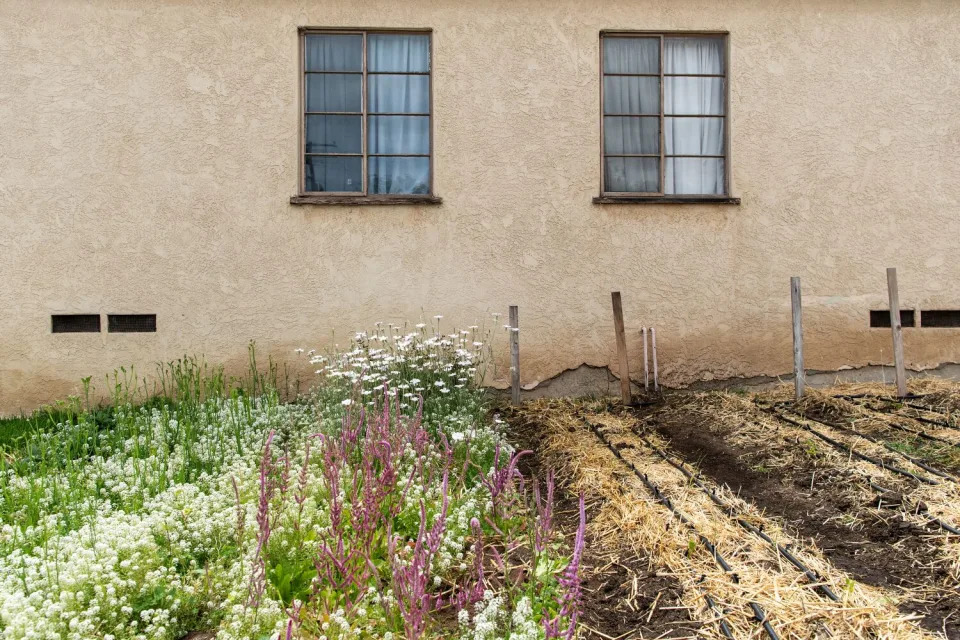
Conserving water is important to Nafis, who subsidizes many of her neighbors’ water bills. “We have everything on a drip system and timers,” she said. “I also use a lot of mulch, which helps to retain water and take care of my soil.”
Although she likes working alone, Nafis’ quiet presence resonates throughout the neighborhood. Shortly before Weaver’s brother, Don, died in 2021, the family moved his hospital bed next to the window so that he could watch Nafis working in the garden.
“It’s extraordinary to be present and so deeply a part of the neighborhood,” she said of the neighbors, dog walkers and parents who greet her as she walks from house to house with her flower buckets and shears.
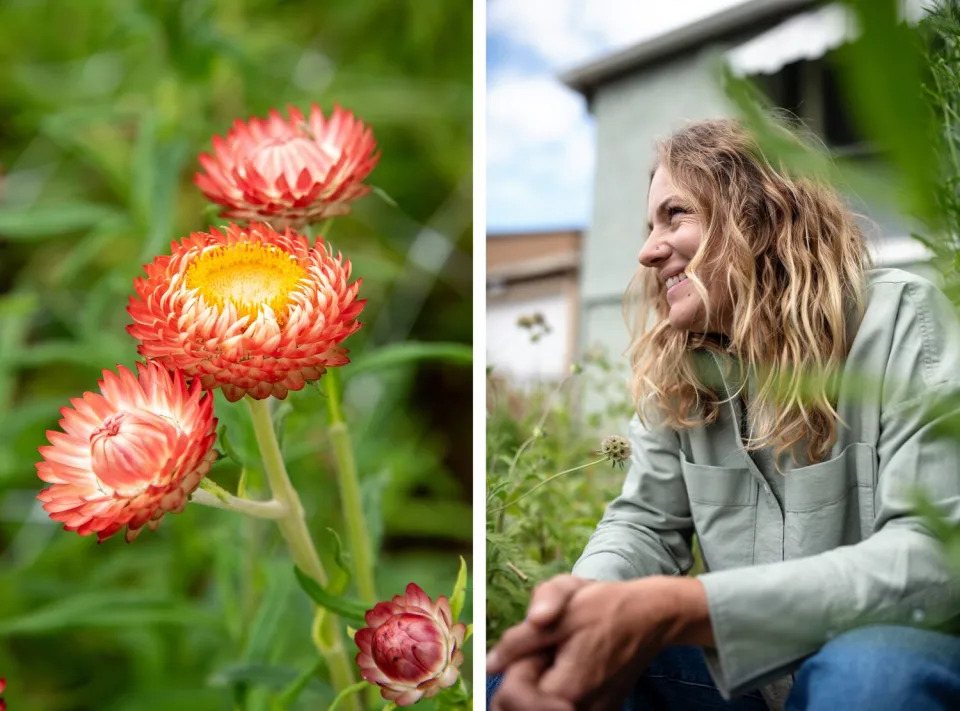
“These have been meaningful life relationships. We’ve had two people pass away since I started this,” she said, her voice breaking. “When you open yourself up to relationships, it can be messy, but I think you can also be amazed by the good things that can happen. My business model is very fragile but not as fragile as you might think. I’m not leasing land with a farm with a five-year commitment. I think that would be ideal, but that’s not a possibility. We couldn’t afford it, but we are grateful to own our house and be able to make a living through this creative shared-land model.”
“All the neighbors know who she is,” said Kristen Kellogg, a nurse practitioner who donated her yard. “We have five sisters in the neighborhood who live in three houses, and when their mother passed away, Rachel was able to make arrangements for them. They knew the flowers were from Rachel, which meant a lot to them.”
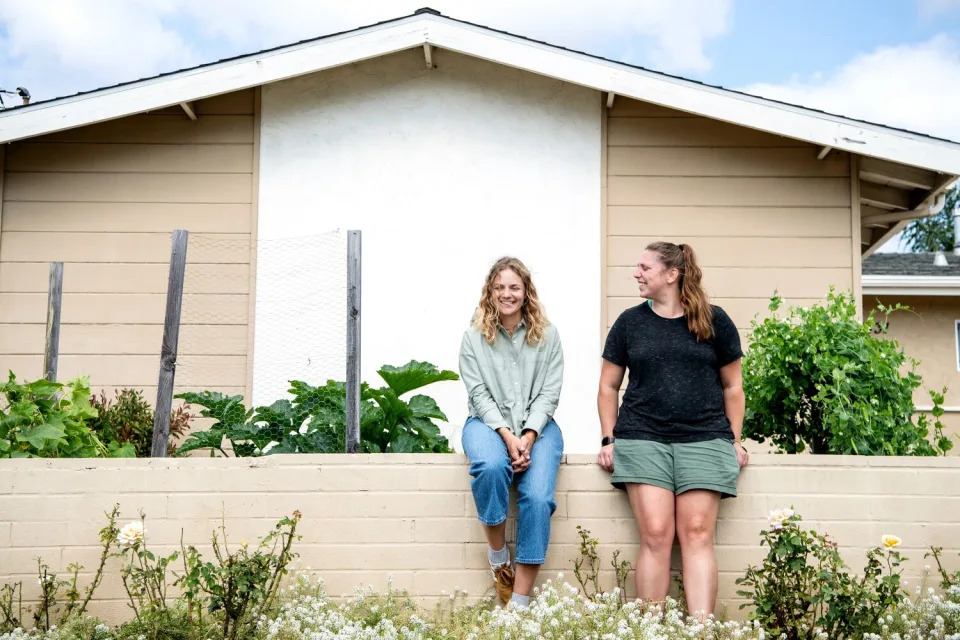

At a time when many people feel isolated and alone, Nafis dropped a written request in Thompson’s mailbox, asking if she could use her yard. “She has become a good friend,” Thompson said. “I have been in and out of some hard transitions, and I have texted her late at night and even asked her if she could come over and help me move a king-sized mattress.”
Nafis, a mother of three young boys, grew up in western Michigan and worked as an ER nurse for 13 years before leaving the profession during the COVID-19 pandemic.
“It was tough,” she said of working as an emergency room charge nurse during the pandemic. “My kids were all home and my husband’s workload increased. The hospital was asking me for more hours. I was burned out. We both worked multiple jobs for many years and decided we couldn’t do it anymore. Changing careers was challenging and such an identity shift from nursing to farming. It was like low-wage manual labor at times. But I couldn’t have imagined doing anything else when we were at a breaking point. I enjoy what I’m doing now.”
Given her small-business success — she’s doubled the farm’s annual revenue every year since its inception in 2019 — Nafis notes that she and her husband, Chris, a pastor, failed miserably in their previous attempts at farming a small community-supported agriculture farm on a vacant lot in Lemon Grove in 2012 and a 45-acre ranch in Jamul in 2013.
“Everything was eaten by rodents in Jamul,” she said. “We lived in a trailer and were both working our day jobs. Anything that was a success was eaten. Even though it was difficult, I think it has been a part of my success.”
In 2014, the couple purchased their home in City Heights and, when not working, tended to a vegetable garden and chickens (that were leftovers from the Jamul ranch). When she planted a row of dahlia tubers in her vegetable garden, she fell in love with the gorgeous ball-shaped blooms, which when cut, would last a week in water. Soon, she decided to experiment with traditional farming, turn her backyard into a cutting garden, and use her neighbors’ yards as satellite farms.

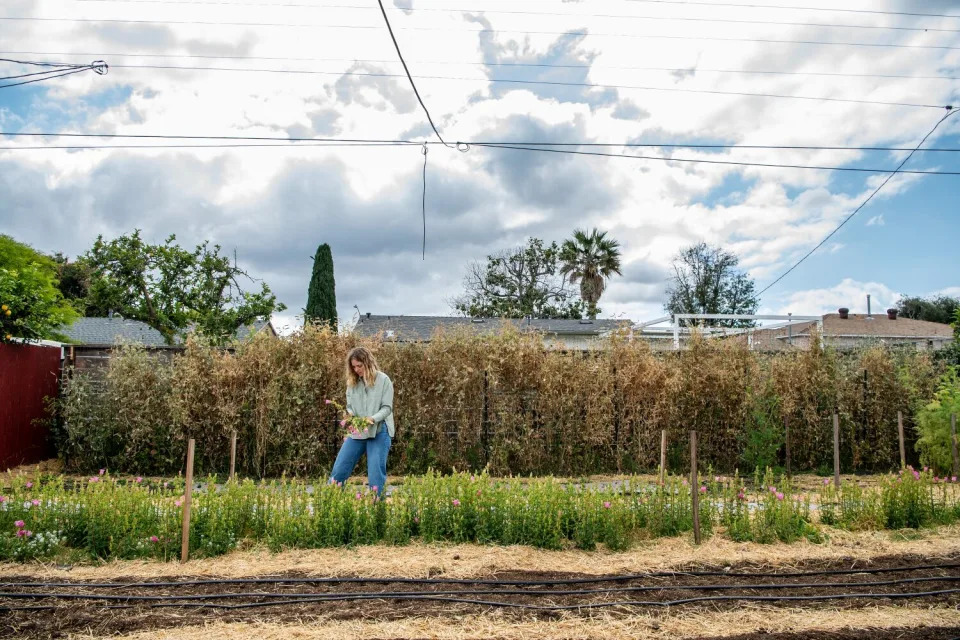
“The model I have created is very relational-based,” she said. “Every house is different based on my relationships with my neighbors.”
Walking through the neighborhood, the flowers are a touchstone that connects her to neighbors and elevates her mood. “I often experience euphoria working with beautiful flowers all day,” Nafis said. “I also appreciate that flowers are appropriate to mark every occasion, from grief and loss to heart-bursting celebration, to long difficult days that drag on forever.”
Nafis thinks her business model resonates with her clients because they care about the environment. “I don’t use any chemicals,” she said. She also utilizes a no-till method that conserves water, feeds the soil and creates a natural habitat for birds and beneficial insects. “Sustainability matters to people,” she added.
The other allure of buying locally grown flowers is the exceptional quality of freshly picked flowers. “There is a real vibrancy when flowers are picked 12 to 24 hours before purchase,” Nafis said. To illustrate this, she collected a chocolate-scented geranium and invited a sniff. “That’s what flowers lose in shipping,” she said.
Nafis also can grow flowers her clients can’t easily find anywhere else. “You can only get corncockle at a local farm,” she said. Other rarities include Iceland poppies, garden roses, foxgloves and lisianthus.
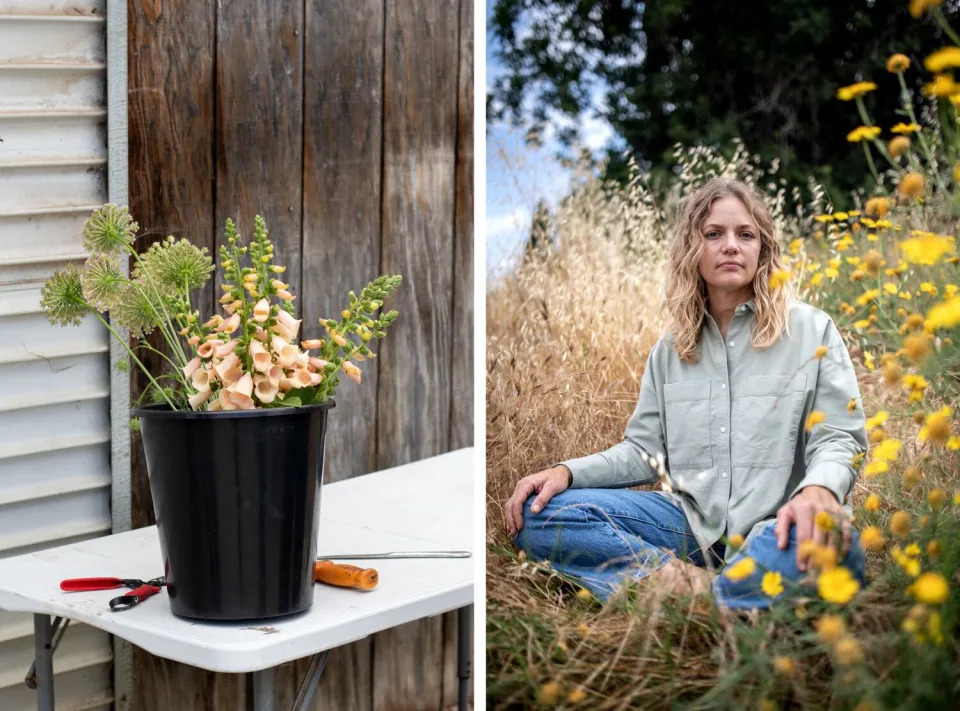
In September when the summer season ends, Nafis will take a break and tend to the soil.
“It’s hard for me to manage, even though I get better every year,” she said. “Plants are living things, and so many different variables are involved: losses to insects and rodents, succession planting. The cutting of flowers is labor-intensive because they need to be cut twice a week, and that never ends. Even when I’m not selling, I need to deadhead the flowers so they don’t go to seed.”

The hard work has taught her to create boundaries for herself such as inviting her subscription clients to pick up their bouquets on her front porch instead of driving all over San Diego to deliver them herself. But for her neighbors, the close bonds remain.
“She has made such an impact on the neighborhood,” Kellogg said. Flowers may be transient, but friendships can last a lifetime.
“Yes, she’s a florist,” she said. “But it’s about a lot more than just flowers.”
This story originally appeared in Los Angeles Times.
![]()
Views: 20
22 named to inaugural class of the National High School Football Hall of Fame.
Last week we shared a list of 50 legends of the game that were eligible to be inducted into the inaugural National High School Football Hall of Fame class. Today the names of 22 of them were chosen to be enshrined.
According to a press release from Russell Johnson, here is the 2023 inaugural National High School Football Hall of Fame class.
1. RB Jim Brown: Manhasset High School Class of 1953
2. Coach Paul Brown: Massillon Washington High School Class of 1925
3. QB Bernie Kosar: Boardman High School Class of 1981
4. QB Archie Payton: Drew High School Drew Class of 1967
5. QB Peyton Manning: Isidore Newman High School Class of 1994
6. QB Eli Manning: Isidore Newman High School Class of 1998
7. QB Cooper Manning: Isidore Newman High School Class of 1992
8. RB Mike Doss: Canton McKinley High School Class of 1998
9. LB Chris Speillman: Massillon Canton, Ohio Class of 1983
10. Coach Thom McDaniels: Canton McKinley High School, Ohio
11. RB Kevin Mack: Kings Mountain High School Class of 1981
12. DB Ray Freeman: Warrensville Hts High School Class of 1981
13. RB Marcus Dupree: Philadelphia High School Class of 1981
14. RB Archie Griffin: Eastmoor High School Class of 1971
15. RB Greg Cameron: University High School Class of 1980
16. RB/LB Jerry Ball: Position West Brock High School Class of 1983
17. DT Horace Sheffield: Cass Tech High School Class of 1972
18. Coach Ted Ginn, Sr. Coach at Glenville High School in Cleveland, Ohio
19. OT Lomas Brown: Miami Springs High School Class of 1983
20. ATH Greg Kampe: Defiance High School, Ohio Class of 1973
21. Coach Don Nehlen: Coach at Canton McKinley High School, Ohio
22. RB Marion Motley: Canton McKinley High Class of 1939
These individuals will be officially enshrined at the NHSFHOF in Canton, Ohio on Sunday, July 30th at the Timken Career Campus.
![]()

Views: 27
Childhood Dream Powers Opening of Mount Granita Storefront in Little Italy.
Opening a storefront on Murray Hill Road in Little Italy was always in the back of Christopher Giancola’s mind. As a 12-year-old boy, he helped his great-grandparents paint the inside of their apartment building between tenants. He climbed up the ladder and began painting the walls. He lifted one of the tiles and saw a beautiful tin ceiling above.
“That’s when I knew, I’m going to do something with this one day, and here we are,” says Giancola, owner of Mount Granita.
Mount Granita opened its storefront on May 19, 2023, after three years of running the business from a street cart in front of the building. They serve authentic Sicilian granita inspired by Giancola’s family heritage. His great-grandparents immigrated from Sicily in 1955, and he remembers watching his great-grandmother Emilia Pinzone make granita.
“She used to make a granita very simply,” Giancola says. “It was the espresso flavor granita, which is just basically leftover espresso from the stovetop, mixed with some sugar and then put it in the freezer and mix it up after a little while. It was a good way of making something out of basically nothing.

Christopher experimented with many recipes and is dedicated to only using fresh fruit and no syrups. He took his inspiration from the traditional flavors and processes of granita made in Sicily.
All of Mount Granita’s flavors are made with natural ingredients. Step 1 in their process is to find good-quality, reliable, fresh fruit. Step 2 is to mix the perfect ratio of fruit to cane sugar to water. Then the mixture is put in a machine for a spin while it’s freezing, and the end product is a smooth, refreshing, cold and fruity treat.
Because no stabilizers or preservatives are used in the product, they hand blend every flavor each day to get it back to the fluffy smooth consistency before opening.
“Granita is something that reminds me of what my grandma would make, and it’s something that’s traditional to me and holds a very sentimental place in my heart,” he says.
The building has been in his family for more than 60 years when his great-grandfather bought the building after it was converted into an apartment. From 1914 to the early ’60s, the building housed several merchants and businesses.
“Many of the side streets in Little Italy used to have dozens of different niche stores,” Giancola says. “Our building was first a small grocery store. At one point, it was a barber shop, a diner, an ice cream shop, a shoe cobbler and an art studio.”
Before they renovated the building, two drop ceilings covered the original tin ceiling, plaster and drywall was crumbling off the original brick walls and several layers of flooring covered up the original maple floors.
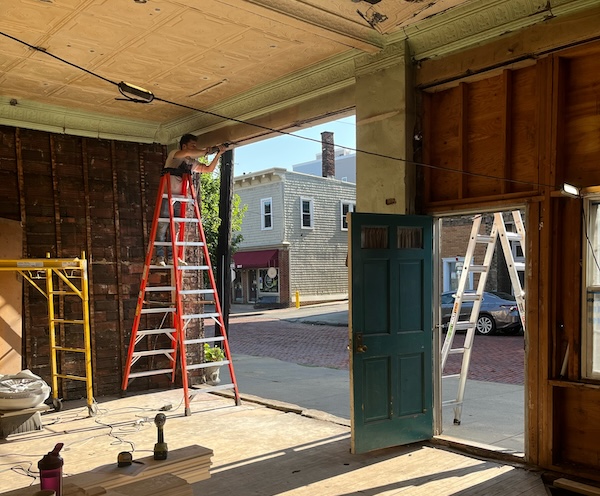
With the help of family and friends, Giancola worked hard to restore and uncover the building to show off the craftsmanship, the building materials and the building quality that existed in the early 1900s.
When remodeling the building, Giancola wanted to keep the building’s traditional look. He wanted it to look like it belonged in the neighborhood, so he chose to install a striped awning reminiscent of storefronts he saw in old photographs of Little Italy.
It was important to Giancola that his storefront had a serving window to emulate the original street cart and to encourage a sidewalk presence, which, he believes, is the best way to meet people and to have a healthy neighborhood.
“Sometimes as you’re walking along the street, you don’t really want to go into a place, you just want to experience a place,” Giancola says. “The sidewalk part of it was important to us. It’s something for everybody, that includes our bubble machine. Even if you’re not coming to our shop, it’s just something that fills the air and brings up the spirit a little bit.”
![]()
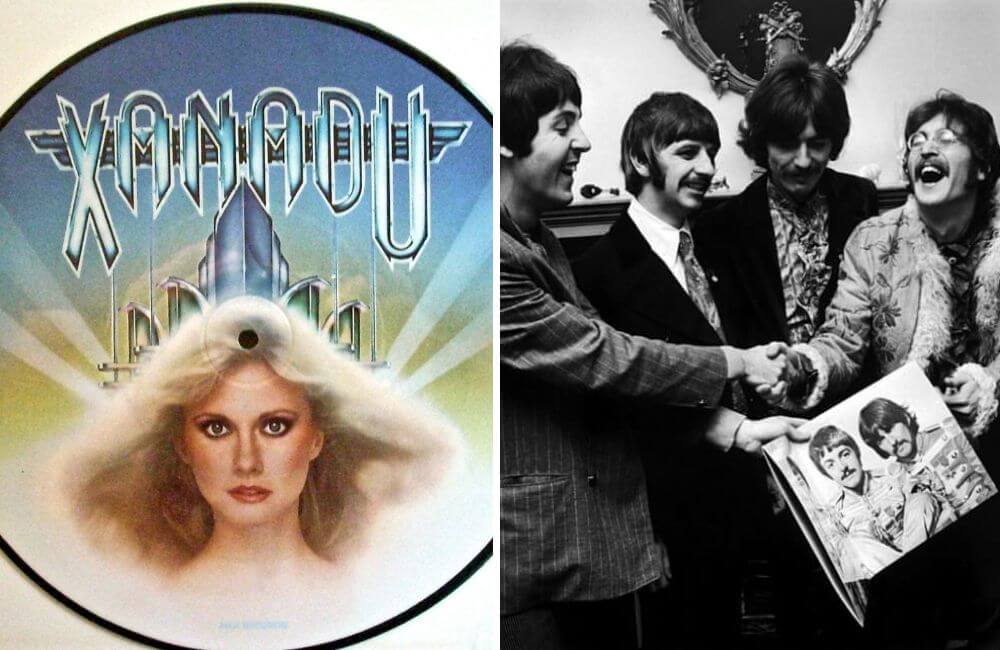
Views: 176
Old Vinyl Records That Are Worth Thousands Today.
By
Today we live in the digital age, when the thought of a physical copy of our favorite record probably doesn’t even cross one’s mind. But just a few short decades ago we were all buying up vinyl records when we wanted to listen to some tunes. You might even still have a box (or two) in the garage gathering dust.
Vinyl records probably seem like a blast from the past to most people. The first vinyl record was invented in the early 1900s, but it wasn’t until 1930 that RCA Victor launched the first-ever, long-playing commercial record. Since then vinyls have waxed and waned in popularity, but one thing is for sure: you can make a lot of money from old vinyl.
As technology has advanced, vinyl records have become a collector’s paradise. Stumble across a rare copy of a certain album and you could be sitting on a gold mine. Do you have one of these rarities lurking in your attic? It might be time to check for these old classics!
Year: 1930
Record label: Paramount
Worth Today: $37,100*
Who doesn’t love a rare blues record? Tommy Johnson released Alcohol and Jake Blues in 1930 after landing a distribution deal with Paramount. Even back then, that was a huge deal. The master tapes to the record no longer exist, making every single copy (and there are few) invaluable.
 Tommy Johnson | Wikipedia.org
Tommy Johnson | Wikipedia.orgJohnson was one of the most influential American Delta blues musicians to record during the late twenties, and his style influenced the styles of other artists (whose vinyls are likely worth a pretty penny nowadays) like Howlin’ Wolf, Robert Nighthawk, and Canned Heat, a band that got its name from Johnson’s song, “Big Road Blues.”
In 2013, buyer John Tefteller shelled out $37,100 to become the proud new owner of one copy. He already had one, but according to him, this version was in much better condition. The purchase made sense to him as the vinyl is just so rare it would be stupid not to buy it!
Year: 1966
Record label: Capitol Records
Worth Today: $125,000*
Sometimes, it’s not just the record itself that draws attention, but the artwork. 1966’s Yesterday & Today by The Beatles proved to be famous for more than just John and Paul’s lyrical talents. The compilation album originally had the band on the cover covered in meat. The record label wasn’t too thrilled so decided to swap it out for something more palatable.
 article-image-old-vinyl-that-could-be-worth-thousands-the-beatles-yesterday-today-2
article-image-old-vinyl-that-could-be-worth-thousands-the-beatles-yesterday-today-2Yesterday and Today was the Beatles’ ninth album on Capitol Records, and it actually contained songs that Capitol refused to release from the band’s EMI albums. It also had songs that the Beatles released elsewhere in non-album form. The idea was to drive up fan purchasing, and Capitol ended up being very successful in that.
There are a select few versions of the album with the original cover still circulating. In February 2013, one such copy sold for $125,000. That’s a lot of money to spend on one circular piece of plastic, but it’s gold dust to collectors.
Year: 1984
Record Label: Festival Records
Worth Today: $9,000*
Irish superstars U2 have made an absolute fortune from their body of work. Back in the ‘80s, they were busy recording “Pride (In The Name of Love).” While usual copies of the record are everywhere, it’s the Australian presses that are incredibly rare and noteworthy.
 U2 @Julie Kay / Pinterest.com | Pride (In The Name Of Love) (1984) @zarank_fuppa / Twitter.com
U2 @Julie Kay / Pinterest.com | Pride (In The Name Of Love) (1984) @zarank_fuppa / Twitter.comThe lead single of the album, “Pride,” was written about civil rights icon Martin Luther King Jr. At the time, it received mixed critical reviews, but it has gone on to be one of the band’s most well-known, popular songs. “Pride” has been on countless compilations since the band’s early days.
There are said to be only 50 copies of the translucent vinyl ever made, but a large portion of those no longer exist. We can’t be sure exactly how many copies remain, but when they do surface they can sell for around $9,000. Bono won’t be buying it though – he’s not a massive fan of the song.
Year: 1973
Record Label: Columbia
Worth Today: $5,000*
Many people might assume that Bruce Springsteen found instant success when he released Born to Run, but he had been hard at the grind for some time prior. His first single was 1973’s “Spirit in the Night.” At the time of its release it largely went unnoticed, but when The Boss hit the bigtime the single became increasingly sought after.
 Bruce Springsteen @Gail Mihalkanin / Pinterest.com | Spirit in the Night (1973) / Wikipedia.org
Bruce Springsteen @Gail Mihalkanin / Pinterest.com | Spirit in the Night (1973) / Wikipedia.orgOnly a limited amount were pressed, so if you have a promotional copy lurking in your record collection it could fetch hundreds. The originals come at a much heftier cost, usually setting lucky buyers back around $5,000.
The backstory behind “Spirit in the Night” is interesting. Clive Davis, upon receiving Springsteen’s debut album, became concerned about commercial appeal after he received the record. He refused to release it without more singles, and that led to Springsteen writing “Spirit in the Night,” as well as “Blinded by the Light.”
Year: 1968
Record label: London
Worth Today: $17,000*
In 1968, could pre-fame Rolling Stones have realized just how lasting their legacy would last? Probably not. The band was too busy dating gorgeous women and living the jetset life of rock ‘n’ roll stars to think about hardly anything other than music.
 The Rolling Stones – Street Fighting Man (1968) ©GAB Archive/Getty Images | @StonesData / Twitter.com
The Rolling Stones – Street Fighting Man (1968) ©GAB Archive/Getty Images | @StonesData / Twitter.comNever ones to shy away from controversy, the band originally featured a harsh black and white image of a policeman standing over injured protesters on the sleeve for “Street Fighting Man.” The record label decided this wasn’t a good idea for the time and destroyed all the copies of the original. Only 18 of the records made it out alive. In 2011, one of these rarities sold for $17,000.
Later, in 1995, Mick Jagger would be interviewed in Rolling Stone by Jann Wenner, and he didn’t hold back. Jagger said that he thought that the seventies’ unrest was “a very good thing.” Jagger, according to his bandmates, was even part of the Grosvenor Square demonstrations and was arrested and charged by police.
Year: 1958
Record label: Kensington
Worth Today: $3,500*
Before Paul McCartney, George Harrison, and John Lennon found Ringo Starr and became The Beatles, they were busy trying to make a name for themselves as The Quarrymen. In a bid to take their first steps to success, the group recorded a cover of Buddy Holly’s “That’ll Be The Day.”
 The Quarrymen | That’ll Be The Day ©ebay | @ebaycouk/Pinterest
The Quarrymen | That’ll Be The Day ©ebay | @ebaycouk/PinterestThe single was never properly released, with Paul only pressing around 50 copies to give to family and friends as a gift. The original copy might be worth an extraordinary amount of money, but reprints still come with a price tag of over $3,500.
In 1997, the Quarrymen had a joyous reunion when the four original, surviving members joined up to play a concert together. They were performing at the fortieth anniversary of McCartney and Lennon meeting (they met at a garden fete). Today, three original members still perform under the Quarrymen band name.
Year: 1972
Record label: ABC Records
Worth Today: $1450.00*
Recorded in 1972 in Los Angeles’ The Village Recorder, Can’t Buy A Thrill was Steely Dan’s debut album. It was released in November of 1972, and it marked the beginning of a successful career for the American rock band. The classic rock album kicked off with “Do It Again” and ended with “Turn That Heartbeat Over Again.”
 Steely Dan – Can’t Buy A Thrill ©Steely Dan / Pinterest.com | ©discogs / Pinterest.com
Steely Dan – Can’t Buy A Thrill ©Steely Dan / Pinterest.com | ©discogs / Pinterest.comThe artwork on Can’t Buy a Thrill was done by Robert Lockhart and features a scene from Rouen, France (it was banned in Spain). The album’s cover art was later called the seventies “most hideous album cover” by Steely Dans own members, Donald Fagen and Walter Becker.
Year: 1956
Record label: RCA Victor
Worth Today: $1530.00*
Rock N Roll by Elvis Presley was the UK version of the rock star’s debut album. In America, Presley’s debut was eponymous. Rock N Roll, at the time of its release, was still very novel for certain major labels. The genre itself was uncharted waters for major labels, but Rock N Roll proved the success of the genre.
 Elvis Presley – Rock ‘N’ Roll ©ChrisJericho / Facebook.com | @djjoeterra0566/Pinterest
Elvis Presley – Rock ‘N’ Roll ©ChrisJericho / Facebook.com | @djjoeterra0566/PinterestThe album would sell over one million units, making RCA, the record label on which it was recorded, its first million-dollar album. William Robertson took the photo that is on the album cover. Rock N Roll’s album cover made Rolling Stone’s “100 Greatest Album Covers” list in 1991.
Year: 1997
Record label: Parlophone, Hollywood
Worth Today: $1413.00*
Queen Rocks is unique for Queen. It is a compilation album, but it doesn’t really follow the usual “Greatest Hits” format. Instead, it focuses on deep tracks (though there are a few hits). Other tracks on Queen Rocks include songs that weren’t released as singles, including “Sheer Heart Attack,” “Tear It Up,” and “Put Out the Fire.”
 Queen – Queen Rocks @aqueenofmagic / Twitter.com @THEDREAMASTER / Youtube.com
Queen – Queen Rocks @aqueenofmagic / Twitter.com @THEDREAMASTER / Youtube.comThis unique album was manufactured by EMI. In Europe, it was released on Parlophone, but in America, the label credited is Hollywood. Queen Rocks also featured songs without Freddie Mercury on them, yet another reason that this record is a dark horse among the Queen discography.
Year: 1968
Record label: Apple Records
Worth Today: $790,000*
The Beatles are so huge it’s only natural that they’ve got several special vinyls to their name. Their self-titled double album from 1968 became affectionately known as The White Album. While it sold an astronomical amount of copies, Ringo Starr held on to the very first copy ever pressed.
 The Beatles @Melanie Dacus / Pinterest.com | The Beatles (White Album) @vvangopher / Twitter.com
The Beatles @Melanie Dacus / Pinterest.com | The Beatles (White Album) @vvangopher / Twitter.comThe drummer held on to the record with the serial number ‘000001’ right up until 2015 when he decided to let it go to auction. Julien’s in the U.S. found a buyer for Ringo’s prized possession, collecting $790,000. Incidentally, Starr’s drum kit also sold the same day for an astonishing $2.2 million.
For those who may not know, the Beatles founded Apple Records in 1968. It was originally their creative outlet, and, as time went on, other artists appeared on the record, including Badfinger, Billy Preston, Mary Hopkin, and James Taylor. When the Beatles went solo, Apple Records was home to their mid-seventies solo releases.
Year: 1986-1987
Record label: Warner Records
Worth Today: $42,300*
In 1987, Prince released The Black Album. The promo edition of this vinyl was somewhat obscure. There was no printed title, credits, photograph, or artist’s name. It was simply a black-sleeved disc. Only one emblem was present on the vinyl: a number “25677” on the disc itself.
 Prince ©Featureflash Photo Agency / Shutterstock.com | The Black Album (aka “The Funk Bible”) @RACCOONFM1 / Twitter.com
Prince ©Featureflash Photo Agency / Shutterstock.com | The Black Album (aka “The Funk Bible”) @RACCOONFM1 / Twitter.comThe commercial version of this vinyl had the same number, just in pink. The Black Album was Prince’s response to criticism that he’d become too pop-oriented. The album had heavy subject matter. Prince ordered TBA to be withdrawn shortly after its release, as he was convinced it was “evil.” He replaced it with Lovesexy.
Year: 1998
Record label: Italy Records
Worth Today: $12,700*
The White Stripes haven’t been around for a while, but there’s no denying that they left an impact that can’t be underestimated. Their 1998 single “Lafayette Blues” featured a hand-painted cover by Dave Buick, the founder of Italy Records.
 The White Stripes @thewhitestripes / Facebook.com | Lafayette Blues @WildBrunchRadio / Twitter.com
The White Stripes @thewhitestripes / Facebook.com | Lafayette Blues @WildBrunchRadio / Twitter.comThe White Stripes’, classified as a “garage rock band,” named “LaFayette Blues” after streets around their hometown of Detroit, Michigan. Detroit has many streets with French names. Live Stripes performances of the single have many different arrangements of the names. The B-side of the vinyl contains “Sugar Never Tasted So Good.”
Only a few copies of the single were made to be sold at one of their gigs, meaning they’re worth a sizable sum today. Interestingly, they went for just $6 back then. Now, if you find yourself in the market for a rare record, they’re going for $12,700. That’s more than just pocket change, that’s for sure.
Year: 1967
Record label: Parlophone
Worth Today: $290,000*
When something has been signed by all four Beatles, you know it is going to be worth a lot of money. The Sgt. Pepper’s Lonely Hearts Club Band studio album is worth nearly $300K in that condition. The Beatles released this album on May 26, 1967 in the UK, while the US had to wait a few more days for a June 2, 1967 release.
 The Beatles – Sgt. Pepper’s Lonely Hearts Club Band @bracketgeo / Twitter.com | ©neftali/Shutterstock.com
The Beatles – Sgt. Pepper’s Lonely Hearts Club Band @bracketgeo / Twitter.com | ©neftali/Shutterstock.comThe Sgt. Pepper’s Lonely Hearts Club Band did extremely well in both countries (as did pretty much all The Beatles’ albums). It was on the top of the UK Albums Chart for 27 weeks. In the US, it topped the charts for 15 weeks.
Year: 2015
Record label: RZA
Worth Today: $2 million*
The Wu-Tang Clan certainly know how to pull something spectacular out of the bag. The hip hop collective recorded Once Upon a Time in Shaolin in secret over the course of six years. Instead of leading up to a big release, there was only one copy ever made. It sold for a huge $2 million dollars.
 Wu-Tang Clan – Once Upon a Time in Shaolin @XXL/@OnThinlce/Twitter.com
Wu-Tang Clan – Once Upon a Time in Shaolin @XXL/@OnThinlce/Twitter.comOnce Upon a Time in Shaolin was recorded secretly, and the recording took a total of six years. While it was awaiting auction and sale through Paddle8, a music auction house, it was stored in a secure vault in Marrakech, Morocco at the Royal Mansour Hotel. The album was inspired by Cilvaringz’ research into the Renaissance period of history.
Interestingly, the band put in a clause: “The seller may legally plan and attempt to execute one heist or caper to steal back (the album), which, if successful, would return all ownership rights to the seller. Said heist or caper can only be undertaken by currently active members of the Wu-Tang Clan and/or actor Bill Murray, with no legal repercussions.”
Year: 1977
Record label: Virgin/A&M
Worth Today: $17,000*
As anyone who has ever heard the lyrics to “God Save the Queen” can guess, this B-side vinyl single was really controversial. “No Feeling” was the A-side. Both singles would be included on Never Mind the Bollocks, Here’s the Sex Pistols. “God Save the Queen” released in 1977, during the Silver Jubilee, which was the twenty-fifth anniversary of Queen Elizabeth II taking the throne.
 Sex Pistols ©Koen Suyk / Wikipedia.org | God Save the Queen”/”No Feeling / @Anarka Akaza / Youtube.com
Sex Pistols ©Koen Suyk / Wikipedia.org | God Save the Queen”/”No Feeling / @Anarka Akaza / Youtube.comThe Sex Pistols denied that the single was released because of the event, instead claiming that the timing was coincidental. This vinyl would be banned by the BBC, as well as the Independent Broadcasting Authority. It is still banned to this day.
Year: 1954
Record label: Sun
Worth Today: $4,000*
Hip-shakin’, foot-stompin’ King of Rock Elvis Presley didn’t shy away from covering other people’s songs. While he was in the studio working on other material, Presley started messing around and singing Arthur Crudup’s “That’s All Right.” The producer thought it was incredible, so started to record it.
 Elvis Presley ©Brookranger | That’s All Right (1954) | Wikimedia.org ©CRAVE_Guitars / Twitter.com
Elvis Presley ©Brookranger | That’s All Right (1954) | Wikimedia.org ©CRAVE_Guitars / Twitter.comThe rest is history. The track became Elvis’ debut single, making him one of the most famous people in the entire world. These days, mint condition copies of the original pressing go for around $4,000. It’s largely considered the first ever rock ‘n’ roll track ever to exist.
Rolling Stone agreed that Presley’s cover of the Arthur Crudup song was one of the best songs ever, including it on its 2010 list of music’s “500 Greatest Songs of All Time.” “That’s All Right” ranked 113. Fifty years after its initial issue, the song released as an anniversary CD and topped the charts in several countries.
Year: 1968
Record label: Philips
Worth Today: $5,000*
Elton John is a prime example of a multi-talented artist. Not only can he play piano like no other, he can sing and craft songs that speak to the very heart of his audience. Frankly, he’s a genius. His first single “I’ve Been Loving You” was released in 1968.
 Elton John @Listenary | I’ve Been Loving You (1968) @MusicTheDope / Twitter.com
Elton John @Listenary | I’ve Been Loving You (1968) @MusicTheDope / Twitter.comAmazingly, the single is credited to Bernie Taupin as John was scared to admit that he wrote it himself. He came clean some time later. It’s not that he was scared of Taupin; instead, John wanted to give Taupin writing credits so that the songwriter (who wrote many other songs in their famous partnership) would get his first publishing royalties.
The royalties were short-lived, as “I’ve Been Lovin’ You” was withdrawn shortly after its release. Copies of the single are unusually hard to find, with only one copy known to exist. It’s worth an estimated $5,000.
Year: 1969
Record label: RCA
Worth Today: $1,000*
Led Zeppelin is well known now as a force to be reckoned with in the rock world, but back in 1969 they were still trying to get noticed at all. Their self-titled debut album mixed new tracks with blues, but not everyone was thrilled. Rolling Stone thought it was trash, though they later changed their minds.
 Led Zeppelin – Led Zeppelin ©Chris Walter/Getty Images | ©George Hardie/Wikimedia Commons
Led Zeppelin – Led Zeppelin ©Chris Walter/Getty Images | ©George Hardie/Wikimedia CommonsFormed in London in 1968, Led Zeppelin would go on to be cited as one of the first artists to do heavy metal music. In 1969, they were hoping that Led Zeppelin would be their ticket to the top, but, unfortunately, that debut didn’t pan out that way. However, Zeppelin would bounce back handily.
There are millions of copies in circulation, but one with turquoise lettering is particularly valuable. If this is in mint condition, lucky owners could sell it for around $1,000. Of course, if it’s battered and bruised it might not fetch quite as much at auction.
Year: 1980
Record label: Jet/MCA
Worth Today: $9,100*
Olivia Newton-John may have found great success as Sandy in Grease, but not every movie she made afterwards was a hit. In fact, 1980’s Xanadu was a financial disaster. But while fans and critics alike panned the movie, the soundtrack did pretty well. The singer collaborated with ELO to release a single simply called “Xanadu.”
 Olivia Newton-John and Electric Light Orchestra (ELO) @t2gunner | Xanadu (1980) @RMixoriginal / Twitter.com
Olivia Newton-John and Electric Light Orchestra (ELO) @t2gunner | Xanadu (1980) @RMixoriginal / Twitter.comWhen the single was originally released, Olivia reportedly disliked how she looked on the cover so much that she asked the record company to destroy them all and go in a new direction. They obliged, with only 20 to 30 copies escaping. These rare finds go for around $9,000.
“Xanadu” was the title song of the eighties’ movie, Xanadu. “Xanadu” reached the top of the charts in multiple counties, and it was the only UK number-one single from ELO. For Friends fans, you’ll recognize the song and music video, as it appeared in the episode, “The One Where Rachel and Ross…You Know.”
Year: 1964
Record label: Motown Records
Worth Today: $100.00*
Meet the Supremes was the debut album of The Supremes, the all-female singing group comprised of Mary Wilson, Diana Ross, and Florence Ballard. The group was formed in Detroit, Michigan in the ’60s and went on to become Motown Record’s most commercially successful acts.
 The Supremes ©latoyajacskon / Twitter.com | Meet The Suoremes ©picclick.com / Pinterest.com
The Supremes ©latoyajacskon / Twitter.com | Meet The Suoremes ©picclick.com / Pinterest.comThe original album had 10 songs on it, with Diana Ross singing lead vocals on almost all of them. Eventually, Ross left the group in 1970 to pursue her own solo career. Today, you can find the original album sold on eBay for $100, and even a version signed by Mary Wilson for $2,500.
Year: 1963
Record label: Columbia
Worth Today: $35,000*
Imagine painstakingly compiling an album only for someone to mess it up by putting the wrong songs on it. That’s exactly what happened when 1963’s The Freewheelin’ Bob Dylan was initially pressed.
 Bob Dylan – The Freewheelin’ Bob Dylan @retrospektshop / Pinterest.com | @barbarian47 / Pinterest.com
Bob Dylan – The Freewheelin’ Bob Dylan @retrospektshop / Pinterest.com | @barbarian47 / Pinterest.comThe mistake was caught before its release, but only after a few copies had already been made. Records with the serial number ending in “-1A” include several songs not originally pegged for release, including “Rocks and Gravel” and “Talkin’ John Birch Blues.”
The album, despite the mistakes in the beginning, is no doubt one of Dylan’s most relevant. The Freewheelin’ Bob Dylan took from news stories about the Civil Rights Movement. Though the album contained love songs and surreal humor, we got to see how Dylan really felt about all the turmoil in the sixties.
Year: 1967
Record label: Verve Records
Worth Today: $25,200*
It might be difficult to imagine now, but there was a time when The Velvet Underground was just another obscure band trying to hit the big time. In 1967 they released their debut album, The Velvet Underground and Nico. It displeased the media so greatly that it was largely banned from being played on radio stations.
 The Velvet Underground / Wikipedia.org | The Velvet Underground & Nico (1967) @Albums2Hear / Twitter.com
The Velvet Underground / Wikipedia.org | The Velvet Underground & Nico (1967) @Albums2Hear / Twitter.comThe content was reportedly “too controversial” for the media to play it. Magazines wouldn’t even advertise it. AllMusic’s Richie Unterberger stated that it was “too daring” for commercial radio to want a piece. The Velvet Underground & Nico also came about at a time when underground rock was just getting started.
Only 30,000 copies were sold, but those that were quick enough to grab one were smiling years later – and not because it was so good. Copies are known to go for up to $25,000. If you were into punk in the ‘60s then it may be time to revisit your collection.
Year: 1989
Record label: Sub Pop
Worth Today: $2,500*
Two years before they gained widespread notoriety after the release of Nevermind, Nirvana released their first album, Bleach. Kurt Cobain and Krist Novoselic were both on the record, but Dave Grohl had yet to join the band. Some tracks from the album including “About a Girl” would gain popularity some years later.
 Nirvana @gunsngore | Bleach @forallthejoy / Twitter.com
Nirvana @gunsngore | Bleach @forallthejoy / Twitter.comReportedly, Nirvana practiced nonstop for two to three weeks to prepare to record a full-length album. When the band arrived at Reciprocal Recording in Seattle, Washington, they were ready to create a masterpiece. Recoding took place from December 1988 until January 1989. Though it didn’t chart initially, critics really liked it.
Their debut album only had 1,000 copies pressed the first time around. These originals go for $2,500, while others can be bought for $1,100. The third pressing only contained 500 copies. Of course, prices went up following Kurt Cobain’s tragic death in 1994.
Year: 1963
Record label: Parlophone
Worth Today: $4,200*
The Beatles were in such hot demand in 1963 that their album Please Please Me had to be rushed through production at a great speed. There wasn’t time to be fussy as they needed seven songs to meet their deadline. The band toiled overnight to get the album finished in time, despite the fact that John Lennon had a terrible cold.
 The Beatles @Millie Chandler-Norris / Pinterest.com | Please Please Me (1963) ©Lihat informasi pencipta/Wikimedia Commons
The Beatles @Millie Chandler-Norris / Pinterest.com | Please Please Me (1963) ©Lihat informasi pencipta/Wikimedia CommonsYou’ll notice that the songwriter credits on the vinyl are credited to “McCartney-Lennon.” This was before the credits would read “Lennon-McCartney.” Rolling Stone would later cite this album was “early evidence” of the innovative idea of a “self-contained rock band” that played its own instruments and wrote its own hit songs.
The story behind the album helps rare copies sell for over $4,000. They have to be in good condition for buyers to take a keen interest, but even if they’re not mint they can still fetch a couple of thousand.
Year: 1973
Record label: Harvest Records
Worth Today: $3,242.31*
While Dark Side of the Moon is one of the most popular and ubiquitous albums in the world, a first-pressing vinyl in mint condition can sell for thousands at auction. Pink Floyd’s Dark Side of the Moon was recorded at the famous Abbey Road Studios. It took Pink Floyd two sessions, completed in January of 1973.
 Pink Floyd – The Dark Side Of The Moon @Gilava / Pinterest.com | @Martin Amos / YouTube.com
Pink Floyd – The Dark Side Of The Moon @Gilava / Pinterest.com | @Martin Amos / YouTube.comAlan Parsons was the staff engineer, and Parsons had already worked with Floyd on Atom Heart Mother. He also was a recording engineer for Abbey Road and Let It Be, two of the Beatles’ most popular records. Dark Side of the Moon was recorded on the Harvest Records label.
![]()

Views: 36
Gather ’round the campfire. Fireside stories connect people across generations, and pass down our diverse cultures.
BEDFORD, Pa. — Sitting around a campfire last weekend with his four great-grandchildren, my father regaled them about the time he was pulling his Thompson Sea Coaster out of Georgian Bay with his truck when disaster struck.
It was 1966 — a time without cell phones or four-wheel drive — and he was cranking the winch when the emergency brake on the truck failed. He watched helplessly as his brand-new yellow Ford submerged under the water — the headlights somehow staying on the whole time.
With that campfire tale, he introduced the children — all of them born 80 years after himself and 120 years after his parents — to a different time, to places and people they had never heard of before: the Grey Bruce Peninsula and Lake Huron, my father’s career designing glass furnaces for PPG and of course the colorful reaction of their immigrant great-great-grandmother, who was on that trip.
I’m pretty sure the enthralled children will pass that dramatic and humorous story down to future generations, introducing some future campfire children to a man they will have never met.
Folklorist Steve Zeitlin said what my father gave my grandchildren was the priceless gift of connectivity across the generations, best described decades ago by American anthropologist Margaret Mead.
“In his storytelling there is something like five generations of living memory that can be carried on,” said Mr. Zeitlin, who is the founder of City Lore, New York’s center for urban folk culture. “In America that is one of our great cultural treasures because of the diversity of our people.”
“There’s just so many threads of immigrant and also native stories — whereas if you grew up in Europe or in France or in most countries in the world, you have one line of stories. But here, there’s so many different groups, and from Jews to African Americans to Native Americans to Italians to Irish,” he said.
All of these groups have had great storytelling traditions that have intermingled, creating unbelievably good storytellers in many different media. “I think that’s why American literature and American storytelling is so rich,” Mr. Zeitlin said.
The tradition of storytelling often fell to the elders in a family or to a tribal leader in a village, and always involved multiple people listening to the stories — often harrowing tales of grit and perseverance from a family’s or a village’s history, explained Dave Isay, the founder of StoryCorps, a nonprofit that preserves Americans’ stories by recording and archiving generational conservations.
All of those family histories are the story of America.
Mr. Isay said he began StoryCorps in 2003 — at a booth in New York’s Grand Central Station — as he watched the digital age start to replace human engagement. Twenty years later, over 700,000 people across the country have volunteered for StoryCorps interviews, in which people ask their loved ones questions about their lives, revealing stories that might otherwise go untold.
Mr. Isay said all of those stories are recorded and placed for generations to come in the Library of Congress. “It is the largest collection of human voices ever assembled,” he said.
StoryCorps travels around the country with Airstream trailers — mobile “campfires,” if you will — to which you can bring your mom, your grandma or anyone you want to honor by listening. The participants simply step inside the Airstream and talk.
At the end of the interview, the participants get a copy of the recording, and another is sent to the Library of Congress — so that their great-great-great-grandkids will be able to hear their voices and learn.
“To be honest, StoryCorps is less about storytelling than about listening, and I think a lot of what’s important about storytelling, in many cases, is the listening. When you sit in a booth with your grandkid, they’re reminding you that you matter and you and your experiences and your part of the fabric of this country won’t be forgotten,” he said.
The project has earned support from across the political spectrum.
Mr. Isay said storytelling transmits the collective wisdom of humanity. “I think that there’s so much to learn from the stories and the poetry and the wisdom that is hiding in plain sight all around us when we take the time to listen — and much more important than the nonsense we’re fed 24 hours a day.”
A story well-told shakes you by the shoulders and reminds you what’s important, and often what’s important is our connections to other people.
“Storytelling around the campfire or in our living rooms has the opposite impact that a lot of social media does on us — and has a possibility for healing some of the fraying fabric of our country that is being ripped apart so quickly because we don’t have proximity to each other,” Mr. Isay said.
In many ways, podcasts have renewed the art of the amateur American folklorist. While most people listen alone to a podcast downloaded from a server onto an iPhone, there is a growing trend of people holding get-togethers — podcast parties — to listen to episodes together, returning to the communal aspect of storytelling.
Outdoorsman, hunter, New York Times bestselling author and host of the long-running television show “MeatEater,” Steve Rinella has a podcast that averages a whopping four million downloads a month. He and his guests spin stories of adventure and history that often have listeners on the edge of their seats.
Mr. Rinella said in an interview from Alaska that good storytelling — whether it be around a campfire, on a fishing boat in the middle of a lake or on a podcast — tends to gain energy from itself, and one story jolts another storyteller in the group to remember something that happened to them or someone they know.
“We’ve had multiple people who’ve been mauled by grizzly bears come on the show, and incredible experiences which led me to seek out good stories from regular people whose experience wasn’t exactly the right format for a podcast but deserved something much more,” Mr. Rinella said. Those stories became his New York Times bestselling “Camp Fire Stories” audiobook of 16 often perilous but inspiring true stories told in the spirit of a gathering ‘round the campfire. The audiobook was so wildly popular it inspired a second edition — and a third that will be coming out in the summer of 2024.
Relaying stories from an experience or a time gone by is a gift we give to our future generations: My grandchildren begged for so many stories last weekend my father eventually lost his voice.
Mr. Rinella says he gets it: “My father served in World War II. He and his friends who were veterans, would tell riveting stories about the war, and they were out outdoorsmen, and they would tell riveting stories about the outdoors.”
“Looking back on it now and looking at who he could have hung out with and who he chose to hang out with, he was attracted to really colorful storytellers, and I now realize that he went out of his way to introduce me to, to expose me to colorful characters who told great stories, and it was appreciated and cherished,” Mr. Rinella said.
Stories he now shares with his three children.
North Side native Salena Zito is a national political reporter for The Washington Examiner, a New York Post columnist and co-author of “The Great Revolt”: zito.salena@gmail.com.
![]()